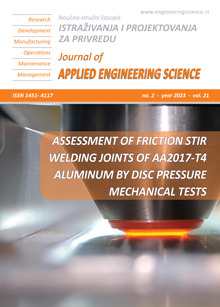SUSTAINABLE RECYCLING OF POLYETHYLENE WASTE THROUGH UTILIZATION IN ASPHALT PAVING APPLICATIONS
Abstract
One the enormous amount of waste polyethylene (PE) materials amassing in Iraq is posing an expensive landfill and disposal issue. The current study examines the potential for employing PE as a partial replacement for environmentally friendly pavement construction. Different amounts of PE were used to partially replace asphalt cement (3 %, 6 %, 9 %, and 12 % by weight). The PE-substituted asphalt (PESA) binders were subjected to the rheological and compatibility properties. Additionally, two asphalt concrete (AC) mixtures—one control and one PEAC—were created for the mechanical and durability experiments. Among the parameters assessed during the tests are the following: adhesion to a variety of substrates and substrate surfaces; elongation at room temperature (aging index); flexibility at elevated temperatures (cracking index); temperature susceptibility; compatibility; and the extensional viscosity of the PESA binder as well as the extensional viscosity of the PESA-mixture (PESAM). Furthermore, the mechanical and durability properties of AC and PEAC mixes were examined using the Marshall stability, Marshall quotient, static indirect tensile strength at 25 and 60°C, tensile strength ratio, and resilient modulus 25°C tests. Results show that PESA binder outperforms virgin asphalt binder in terms of cracking and temperature resistance. PEAC mixture exhibits higher stability, indirect tensile strength, moisture resistance and resilient modulus than AC mixture. According to standard and durability testing, replacing virgin binder with six percent PE can be recyclable and suitable for use as sustainable material for paving applications.
References
Federal Highway Administration (2016). “Strategies for Improving Sustainability of Asphalt Pavements”, US department of Transportation, Office of Pavement Technology, FHWA-HIF-16-012.
Yetkin Yildirim.( 2007). Polymer modified asphalt binders. Construction and Building Materials. (21): 66–72.
Giovanni Polacco, Jiri Stastna, Dario Biondi, Federico Antonelli, Zora Vlachovicova and Ludovit Zanzotto. (2004).Rheology of asphalts modified with glycidylmethacrylate functionalized polymers. J.Coloid and Interface Science. 2004, (280):366-373.
Al-Hadidy AI, Tan Yi-qiu. (2009). Effect of Polyethylene on Life of Flexible Pavements, Construction and Building Materials Journal, 23, 1456-1464.
Punith V. S., A. Veeraragavan.(2007). Behavior of Asphalt Concrete Mixtures with Reclaimed Polyethylene as Additive. J. Mater. Civ. Eng., 2007, 19(6): 500–507.
Sinan Hınıslıoglu, Emine Agar. (2004). Use of waste high density polyethylene as bitumen modifier in asphalt concrete mix. J Materials Letters. 2004, (58):267-271.
SE. Zoorob, L.B. Suparma.(2000). Laboratory design and investigation of the properties of continuously graded Asphaltic concrete containing recycled plastics aggregate replacement (Plastiphalt). J.Cement and Concrete Composites, 2000, (22): 233-242.
Hee Mun Park, Ji Young Choi, Hyun Jong Lee, Eui Yoon Hwang.(2008). Performance evaluation of a high durability asphalt binder and a high durability asphalt mixture for bridge deck pavements. J Construction and Building Materials, 2008.
Moatasim Attaelmanan, Cheng Pei Feng, Al-Hadidy AI. (2011). Laboratory evaluation of HMA with high density polyethylene as a modifier, Construction and Building Materials Journal 25, 2764–2770.
Mansour Fakhri, Amin Ahmadi. (2017). Evaluation of fracture resistance of asphalt mixes involving steel slag and RAP: Susceptibility to aging level and freeze and thaw cycles, Construction and Building Materials Journal, 157, 748-756.
Al-Ghannam, K.A.A.(1996). Study on the rheological properties of asphalt, effect of modification process on the homogeneity of the system. Ph.D. Thesis, College of Education, Chemistry Department, University of Mosul, Mosul-Iraq, 1996.
Milkowski, W. (1985). Catalytic modification of road asphalt by polyethylene, J.Transportation Engineering. 1985, 11 (1).
Al-Dubabe I.A, Al-Abdul Wahhab H.I., Asi I.M., and Mohammed F.A.(1998). Polymer modification of Arab asphalt. , J.Transp.Eng. 1998, 10(3).
Nolan K.L, Geoffry R.M and Simon A.M.H.(1995). Low temperature fracture of polyethylene- modified asphalt binder and asphalt concrete mixes. AAPT, 1995: 534-571.
American society for Testing and Materials (ASTM), (2000). Standard Specification, Section 4, Vol. 04-03.
State cooperation of road and bridges (SCRB), (2004). “Hot mix asphaltic concrete pavement”, Iraqi standard specification, Ministry of Housing and Construction. Department of Design and Study, Section R-9.
Hailong Jin, Guangtao, YongZhang, Yinxi Zhang, Kang Sun and Yongzhong Fan (2002). “Improved properties of polystyrene-modified asphalt through dynamic vulcanization”. J.Polymer Testing., (21):633-640.
Brown SF and Brunton JM, (1992) “An introduction to the analytical design of bituminous pavements (3rd edition).” University of Nottingham, Department of Civil Engineering, UK.
Anon, (1992) “Residential course on bituminous pavements: materials, design and evaluation.”University of Nottingham, Department of Civil Engineering.
Yang, H.H, (1993). “Pavement analysis and design”, Prentice-Hall, Inc.,A paramount communications company ,Englewood Cliffs, New Jersey 07632,USA, 336- 410.
X. Lu, U. Isacsson (1997). “Characterization of SBS polymer modified bitumen comparison of conventional methods and DMA”, J. Test Eval. 25 (1997) 383–390.
Haas, R. C. G. (1969). "Thermal shrinkage cracking of some Ontario pavements," Ontario highway department report R.R.161, 1969.
Al-Ani T., M., A., (1999). "Influence of accelerated weathering of asphalt cement properties on performance of paving materials," M.Sc., Thesis, university of Baghdad, September, 1999.
Collop AC, Cebon D and Hardy MSA, (1995) ‘A visco-elastic approach to rutting in flexible pavements.’ASCE J. Transp. Eng., 121(1), PP 82 – 93.
ASTM Standard Specifications, (2015). Part IB, Volume 04.03 Road and Paving Materials Vehicle Pavement Systems.
Eldon J. Yoder and Mathew W. Witczak (1975). “Principles of Pavement Design”. Wiley; 2d Edition.
Al-Hadidy AI, Abbas F. Jasim, Abdullah M. Rashed (2021). “Mechanistic analysis and durability of thiophene paving mixtures”. J. Mate. Civ..Eng., 2022, 34(7).

